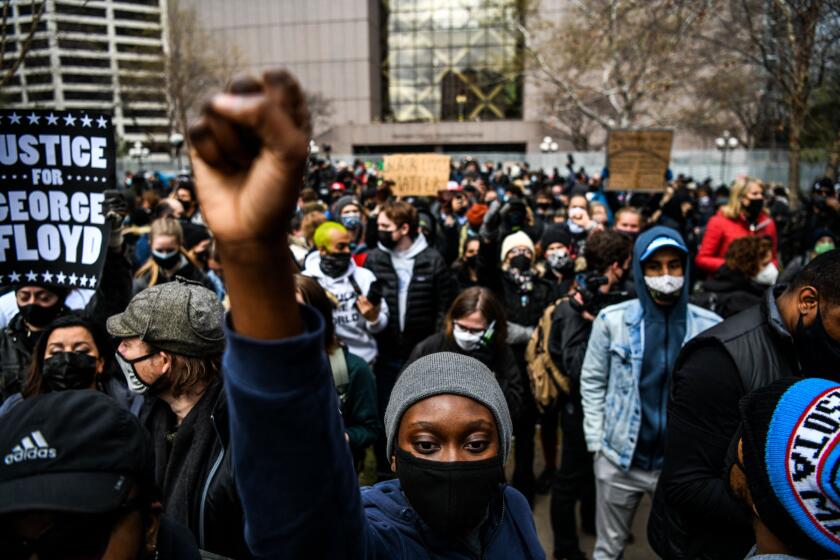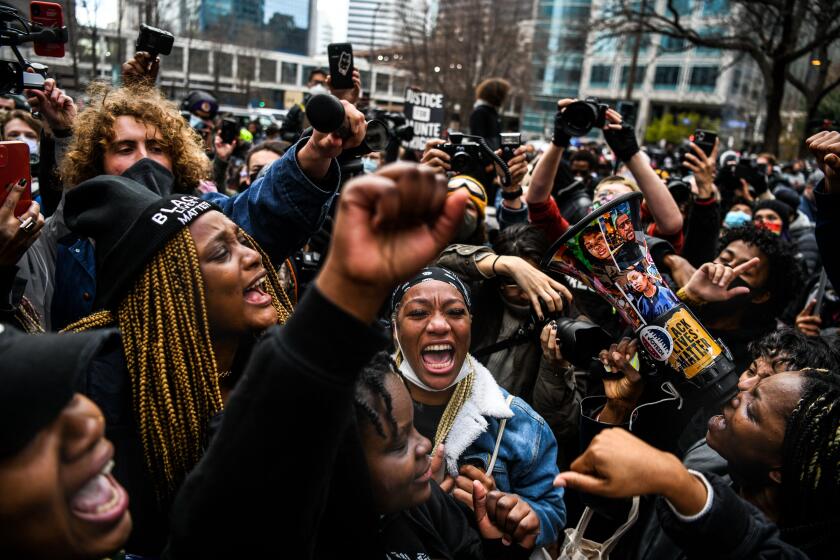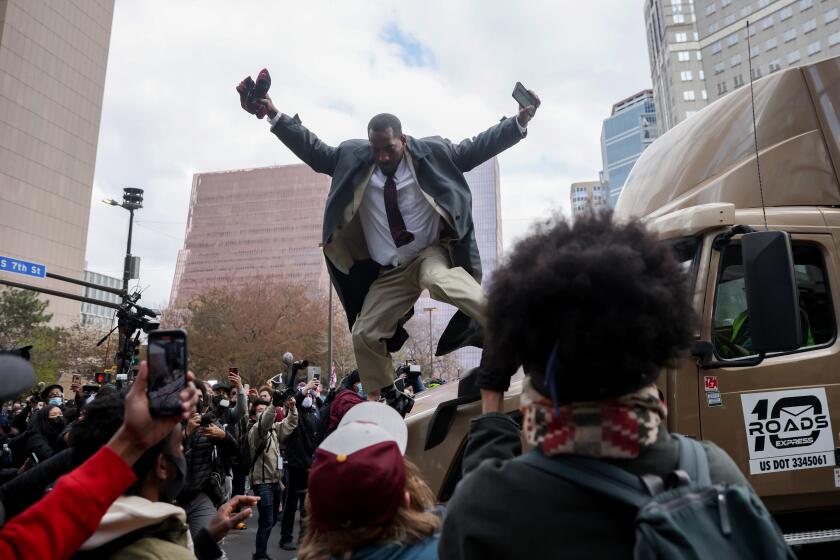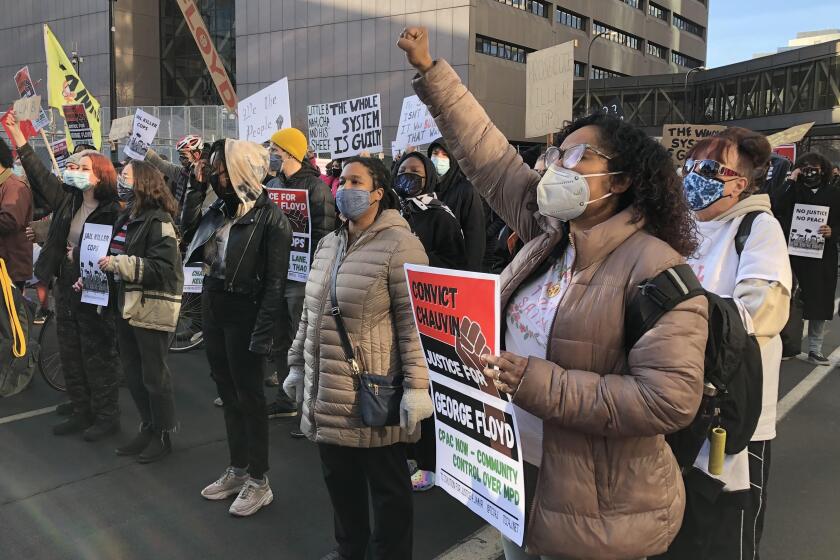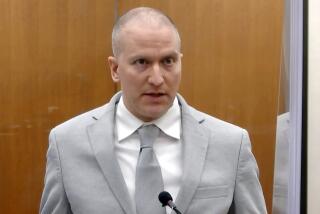What happens to Derek Chauvin now that he’s been convicted of murdering George Floyd
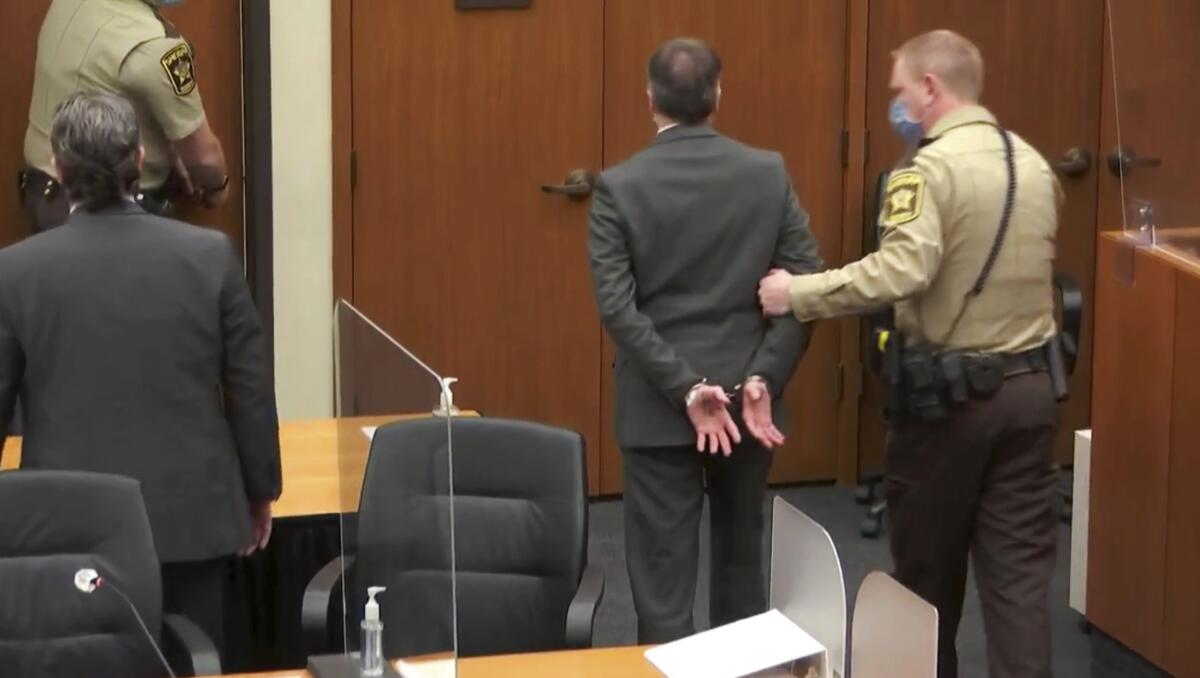
- Share via
MINNEAPOLIS — Derek Chauvin, the former Minneapolis officer who pressed his knee against George Floyd’s neck, was handcuffed and taken into custody Tuesday after being convicted of all three counts against him.
Twelve jurors found Chauvin guilty of second-degree unintentional murder, third-degree murder and second-degree manslaughter, ultimately deciding that Chauvin caused Floyd’s death and that his actions were not that of a reasonable officer.
Prosecutors didn’t have to prove Chauvin’s restraint was the sole cause of Floyd’s death, only that his conduct was a “substantial causal factor.” They also had to prove his actions were unreasonable, because Chauvin was authorized to use force as a police officer, as long as that force would be considered reasonable by an objective officer.
Here’s a breakdown of the charges and what happens next:
What’s second-degree unintentional murder?
It’s also called felony murder. To prove this count, prosecutors had to show that Chauvin killed Floyd while committing or trying to commit a felony — in this case, third-degree assault. They didn’t have to prove Chauvin intended to kill Floyd, only that he intended to apply unlawful force that caused bodily harm.
The landmark case has riveted a nation wrestling with the issues of police brutality and racial injustice it raised.
Prosecutors called several medical experts who testified that Floyd died from a lack of oxygen because of the way he was restrained. A use of force expert also said it was unreasonable to hold Floyd in the prone position for 9 minutes, 29 seconds, handcuffed and face-down.
Defense attorney Eric Nelson tried to raise doubts about Floyd’s cause of death — saying underlying heart issues and drug use were to blame. He also argued that Chauvin’s actions were reasonable, saying Floyd was big, under the influence of something, could start fighting and that nearby bystanders presented a threat.
What about third-degree murder?
For this count, jurors had to find Chauvin caused Floyd’s death through an action that was “eminently dangerous” and carried out with a reckless disregard for and conscious indifference to the loss of life.
Mark Osler, a professor at University of St. Thomas School of Law, said prosecutors tried to prove this through testimony about the dangers of subduing a handcuffed person in the prone position. A medical expert testified about how the restraint would have killed a healthy person, and police use-of-force trainer testified that officers are trained to avoid the neck when possible.
“They wanted to have a lot of evidence showing that what Chauvin did is not what he was trained to do and that the reason they don’t train people to do that is because it’s eminently dangerous,” Osler said.
Across the country, people began to reflect on what it meant for a white officer to be convicted in the killing of a Black man.
And second-degree manslaughter?
Prosecutors had to show that Chauvin caused Floyd’s death through culpable negligence that created an unreasonable risk, and that he consciously took the chance of causing severe injury or death.
Testimony that revealed Chauvin should have known to put Floyd in a side recovery position, that he should have provided medical care before paramedics arrived and that he stayed in his position after he was told Floyd didn’t have a pulse could all point to negligence, said former U.S. Atty. Tom Heffelfinger.
Where is Chauvin now?
Chauvin, who has been free on bail for the last several months, was handcuffed immediately after the verdicts were read and was taken into custody. A sheriff’s deputy escorted him out of the courtroom through an interior door.
The Minnesota Department of Corrections said Tuesday night that he was at the state’s maximum security prison in Oak Park Heights, due to an arrangement with the county sheriff and the Department of Corrections. That’s the same prison where Chauvin was moved after his arrest for security reasons.
Reaction to verdict in death of George Floyd
What sentence could he get?
Each count carries a different maximum sentence: 40 years for second-degree unintentional murder, 25 years for third-degree murder, and 10 years for second-degree manslaughter. But Minnesota has sentencing guidelines that call for far less.
Under the guidelines, a person with no criminal history would receive a presumptive sentence of 12 1/2 years for each murder charge and a presumptive sentence of four years for manslaughter. The guidelines allow for a range slightly above and below those presumptive sentences, which is up to a judge’s discretion.
But in this case, prosecutors are seeking a sentence that goes above the guideline range, called an “upward departure.” They cited several aggravating factors, including that Floyd was particularly vulnerable, that Chauvin was a uniformed officer acting in a position of authority, and that his crime was witnessed by multiple children — including a 9-year-old girl who testified that watching the restraint made her “sad and kind of mad.”
After the verdicts, Atty. Gen. Keith Ellison said his office would be seeking a “fair” and “just” sentence. He would not be specific, but said: “We believe there are aggravating factors and the sentence should exceed the sentencing guidelines.”
So what’s next?
Chauvin waived his right to have a jury consider whether there were aggravating factors that would call for an upward departure — leaving that decision in the hands of Judge Peter Cahill. Cahill said he would give both sides a week to write legal briefs about aggravating factors, then he’ll take a week to issue findings on that issue.
A jury can’t lead systemic change. As long as good cops protect bad ones, we’ll be in the same spot we were the day before Floyd died.
Cahill also ordered a pre-sentence investigation report, which is required in Minnesota and normally confidential. This report is typically prepared by a probation officer and includes information such as a defendant’s characteristics, circumstances, criminal record and social history. It also includes details of the offense and the harm it caused others and the community.
Cahill said both sides will be able to respond to that report before he issues a sentence in two months. An exact date for sentencing has not been set.
Regardless of the final sentence, in Minnesota, defendants typically serve two-thirds of their penalty in prison, with the rest on parole.
More to Read
Sign up for Essential California
The most important California stories and recommendations in your inbox every morning.
You may occasionally receive promotional content from the Los Angeles Times.
